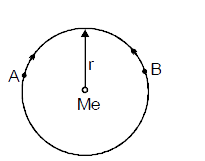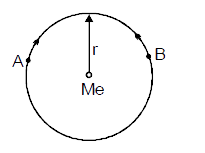Two indentical geostationary satellite each of mass are moving with equal speed in the same orbit but their sense of rotation brings them on a collision course. What will happen to the debris?
The collision of two satellite will be inclastic collision and they stick together after collision. Let be the velocity of two satellies after collision.
According to law of conservation of linear momentum
or
The kinetic energy of the debris in its orbit
Due to gravity, the debris will fall towards Earth. During its fall, it meets with air resisatnce and may get burnt up.
Topper's Solved these Questions
- GRAVIATIONBOOK - PRADEEPCHAPTER - GRAVIATIONEXERCISE - CONCEPTUAL PROBLEMS II.
1 Videos
- GRAVIATIONBOOK - PRADEEPCHAPTER - GRAVIATIONEXERCISE - CONCEPTUAL PROBLEMS III.
1 Videos
- GRAVIATIONBOOK - PRADEEPCHAPTER - GRAVIATIONEXERCISE - CONCEPTUAL PROBLEMS I.
1 Videos
- BEHAVIOUR OF PERFECT GAS & KINETIC THEORYBOOK - PRADEEPCHAPTER - BEHAVIOUR OF PERFECT GAS & KINETIC THEORYEXERCISE - Assertion - Reason Type questions
14 Videos
- KINEMATICSBOOK - PRADEEPCHAPTER - KINEMATICSEXERCISE - 1 NCERT Comprehension
4 Videos
Similar Questions
Consider two satellites A and B of equal mass m, moving in the same circular orbit of radius r around the earth E but in opposite sense of rotation and therefore on a collision course (see figure).
In terms of G, Me, m and r find the total mechanical energy EA + EB of the two satellite plus earth system before collision.

View SolutionConsider two satellites A and B of equal mass m, moving in the same circular orbit of radius r around the earth E but in opposite sense of rotation and therefore on a collision course (see figure).
If the collision is completely inelastic so that wreckage remains as one piece of tangle d material (mass = 2m), find the total mechanical energy immediately after collision.

View Solution
Knowledge Check
Two satellites A and B move round the eaerth in the same orbit. The mass of B is twice the mass of A.
ASpeeds of A and B are equalBThe potential energy of earth +A is same is that of earth +BCThe kinetic energy of A and B are equalDThe total energy of earth +A is same as that of earth +BTwo satellites of same mass m are revolving round of earth (mass M) in the same orbit of radius r. Rotational directions of the two are opposite therefore, they can collide. Total mechanical energy of the system (both satallites and earths) is (m<<M) :-
A−GMmrB−2GMmrC−GMm2rDZeroA ball moving with a velocity of 6 m/s strikes an identical stationary ball. After collision each ball moves at angle of 30∘ with the original line of motion. Assuming that the collision is elastic, what are the speeds of the balls after the collision?
A√32m/s,2√3m/sB3m/s,2√3m/sC2√3m/s,2√3m/sD√3ms,√3m/s
_E01_109_Q01.png)
Consider two satellites A and B of equal mass m, moving in the same circular orbit of radius r around the earth E but in opposite sense of rotation and therefore on a collision course (see figure)
(i). In terms of G,Me m and r find the total mechanical energy EA+EB of the two satellite plus earth system before collision
(ii). If the collision is completely inelastic so that wreckage remains as one piece of tangled material (mass=2m) find the total mechanical energy immediately after collision.
(iii). Describe the subsequent motion of the wreckage.
View SolutionTwo particles each of mass m moving with equal speed 2m/s along the indicated direction in the figure undergo a perfectly inelastic collision.Velocity of combined system after collision is ?
View SolutionTwo objects each of mass 5 kg are moving in the same straight line but in the opposite direction towards each other with some speed of 3 m/s. They stick to each other after collision. What will be the velocity of the combined object after collision?

View SolutionTwo objects each of mass 5 kg are moving in the same straight line but in the opposite direction towards each other with some speed of 3 m/s. They stick to each other after collision. What will be the velocity of the combined object after collision?

View SolutionTwo particles of equal mass are moving along the same line with the same speed in the same direction. What is the speed of the centre of mass of the system ?
View Solution
